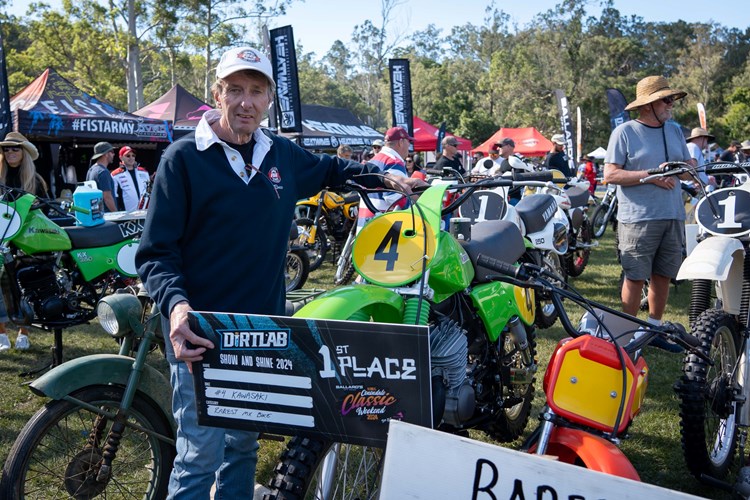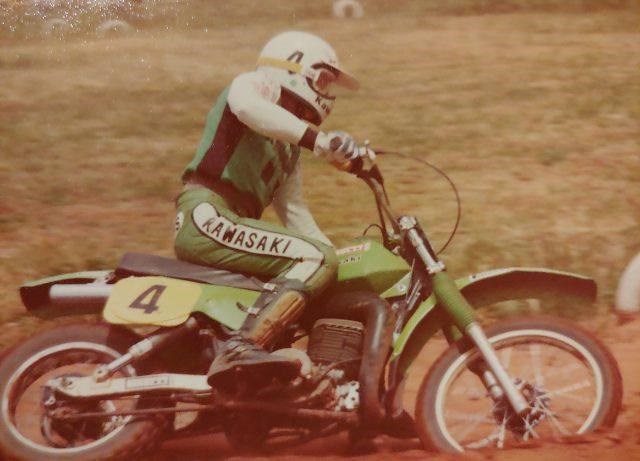LATEST NEWS |
Track and Trail: a very special 1979 Factory KX 380 SR Motocrosser
Australian motorcycle historian Rosco Holden recently reached out to Kawasaki Australia following the completion of his ex Weinert-Mosier in USA and Trev Williams Works 79-SR-380.
Rosco acquired the bike over eight years ago as a pile of parts, and has since completed a full restoration.
After showing the bikes at various events and winning awards, Rosco will be displaying the bike at the VMX Classic Dirt, held 17 2–4 August 2024.
1 of 4 Documented Examples known in the World, there is rumored to be another couple but were put together by spare parts.
This is nearly an eight Year Project and one Expensive Motorcycle, being that Trevor Wiliams the Original Rider owns Doyle and Sheild in Bairnsdale he had no time during the 3 years of Covid and while Adventure /Trail Riding got struck by a Kangaroo and broke his shoulder and was out a further 18 months. Thanks Trev for the Magnificent Restoration.
Special thanks to Kevin Doyle for manufacturing necessary missing parts ie: engine brackets e.t.c., Anthony Gunter Fox Shox Build, John Kral of Kral creations for the Paint, Pete form Melbourne Anodising, Don McGrath for the Rare 17” Pirelli MT Gara-Cross Rear Tyre, Geoff Morris of GM Concepts for Pipe Work, Dave Miller (RIP) GMC for Tank Mould, Darren Cheney for making the Fiberglass Tank, Mark Hilderbrand, Jonathan Wood, Lutz Gerlach for various difficult parts.
The following story was first published in Track and Trail Magazine in April 1979.
One of only a handful in the world, (3) documented and this 380 will stir the local scene up this year.
The guy that the “works” bike success all hinges on in Australia. Trevor Williams.
Frame:
The frame is again smaller to the production motocrossers, having a single down tube emanating from the taper-roller head stem which then separates at its base at the front of the engine into two smaller diameter tubes that triangulate out to either side of the swing-arm pivot point. The frame is straightforward with no unnecessary frills and is light weight and quite rigid.
Suspension:
The suspension, front and rear, is quite competitive by current standards with 280mm (11”) travel from the air-spring front forks, and 300mm (11.8”) rear wheel travel from the well damped, remote oil-gas bowl Kayaba rear suspension units.
The swinging-arm is virtually the same in construction to the production swing-arm, although the actual swing-arm length and the suspension unit mounting point is altered slightly to give the increased rear wheel travel. The swing-arm is fabricated from a combination of pressed alloy sections and alloy die-castings and is of deep-box section.
Chain Guides:
The chain guiding system is identical to the production counter-part having a nylon skate-board roller mounted above the chain, as well as one mounted below the lower run of the chain at the swing-arm pivot point. A molded rubber section is clipped around the front of the swing-arm to prevent the chain from unnecessarily harassing the aluminum swing arm around the pivot area.
The rigid rear chain-guide fits close up to the rear sprocket and feeds the chain between two rubber rubbing blocks and onto the rear sprocket.
The two rubbing blocks are sandwiched between two vertical alloy plates which mount directly to the swing-arm.
Engine:
The engine breathes through a production motocross air-box and filer assembly, then proceeds through a 38mm Mikuni carburetor and Eyving Boyesen read-valve to the 391 cylinder. The combination of an internal rotor CDI ignition system and a compression ratio of 7.45:1 light up the mixture into a usable 46.3 horsepower at 7500 rpm.
The Eyving Boyesen reed-valve has a two-layer reed-petal; that is, the main petal has a rectangular hole in its center, with a smaller additional petal lying flat over the top of the main petal. The combined action of these layered petals is a more flexible reed combination, that breathes well at both high and low speeds.
Due to Kawasaki’s Japan’s increasing interest in the motocross scene, they have made available to Kawasaki Motors Australia, one of their ex-factory KX380SR motocross machine. This motorcycle was used in the American AMA rounds in 1978 by Kawasaki Japan Team riders, Gaylon Mosier and Jim Weimert’s. This year will see A-grade rider Trevor Williams from Bairnsdale, Victoria competing on the KX380SR in the majority of major Australian Motocross and Mr Motocross rounds.
The KX380SR is typical of a factory racing machine; having pre-product sandcast magnesium crankcases, handmade expansion chamber and aluminum muffler, as well as a liberal sprinkling of lightened components.
Mudguards and tank:
The plastic sidecovers and mudguards are identical to the current KX125-A5 motocross, while the pre-production fuel tank, although identical in shape to that of the KX125-A5 is actually made of woven- strand fiberglass matt and is fabricated in three sections. The top of the tank is split into two halves along its centerline.
These two sections are bonded together, then the base is fitted up into them and both bonded and pop-riveted in place. Obviously for a factory special, this type of tank would initially be quick and easy to make and would be of comparatively light weight.
Wheels, Brakes, and Hubs:
The brakes and hubs are actually production die-cast magnesium components straight from the assembly line. However, while the front wheel sports a production 21” DID rim, the rear wheel sports an aggressive looking 17” DID rim, with a Pirelli MT Gara-Cross tyre, but of 4.60x17” size.
The rear bake is of the fully-floating type to prevent any unnecessary rear wheel lock-ups while braking hard into corrugated corners. The anchor-rod which is made of aluminium to further reduce unspring weight, has a roller bearing at the brake plate, and a bronze bush, at the frame end. This, coupled with good anchor-rod and brake-rod geometry, and an alloy brake pedal make for a precise and light weight rear brake assembly.
Looking like the 250 it is scaled up in many ways though, Trick aluminum can-muffler.
Look at the 250 but that’s about all the same, obviously the fore-runners to the latest models.
The hand-made expansion chamber and muffler assembly is impressive. The expansion chamber is made from steel, while the muffler is fabricated from aluminum. With a definite accent toward light-weight, all axis is hollow and the majority of bolts and engine plates are meticulously drilled and lightened to give an overall dry weight of 99kg (218lb).
Conclusion:
Although we didn’t get the opportunity to ride this motorcycle, the combination of long travel suspension, both front and rear, light-weight, and good power, should make the KX380SR very competitive, providing the necessary spare parts are readily available to keep the motorcycle in top form.
The combination of good riders on likewise competitive machine won’t make it a particularly easy row for Trevor Williams to hoe. Although Trevor will be one man amongst a scene of Yamahas and Suzuki’s, he will certainly add a lot of competition and interest to the big-bike class of Australian motocross. Best of luck Trevor.
Massive finning should keep power up and under the hardest conditions.

